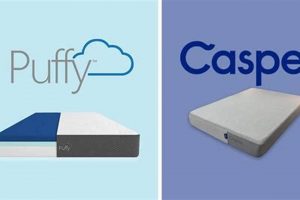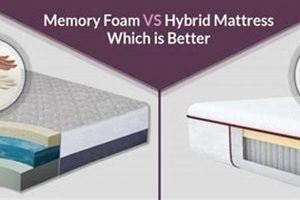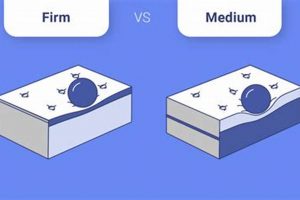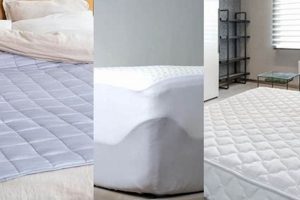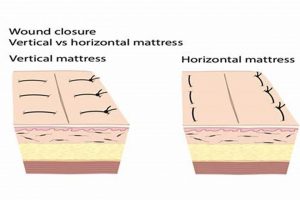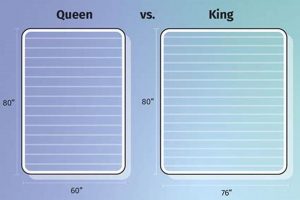The central topic involves a comparison of two distinct materials commonly used in mattress construction. One utilizes a viscoelastic foam designed to contour to the body, while the other incorporates a cooling agent within its structure. These contrasting technologies aim to provide optimal support and temperature regulation for sleep.
Understanding the characteristics of these materials is important for consumers seeking enhanced sleep quality. The conforming nature of one can alleviate pressure points, potentially reducing discomfort and promoting better spinal alignment. Conversely, the other’s cooling properties can mitigate heat retention, creating a more comfortable sleep environment, especially for individuals prone to overheating during the night. Historically, advancements in material science have led to these innovations, each attempting to address specific sleep-related concerns.
The following sections will delve into the specific attributes of each material, exploring their construction, benefits, drawbacks, and suitability for different sleep preferences and needs. Key aspects to consider will include pressure relief, temperature regulation, durability, motion isolation, and cost.
Guidance on Mattress Selection
The subsequent recommendations offer insights into choosing between mattresses incorporating different technologies. Careful consideration of individual needs and preferences is paramount.
Tip 1: Prioritize Pressure Relief. For individuals experiencing joint pain or pressure sensitivity, the viscoelastic foam variant is often preferable due to its conforming properties. It distributes weight evenly, minimizing stress on specific areas.
Tip 2: Evaluate Temperature Regulation. For those prone to overheating during sleep, a mattress incorporating cooling gel may be more suitable. This promotes better airflow and dissipates heat, maintaining a cooler sleep surface.
Tip 3: Consider Body Weight and Sleep Position. Heavier individuals may require a firmer mattress with greater support. Side sleepers typically benefit from a softer surface to cushion their shoulders and hips, while back sleepers often need a balance of support and comfort.
Tip 4: Assess Motion Isolation. If sharing a bed, motion isolation is a critical factor. Viscoelastic foam excels at absorbing movement, minimizing disturbance to a sleeping partner.
Tip 5: Investigate Material Density and Durability. Higher density foams generally offer greater longevity and resist sagging over time. Inquire about the materials used and the mattress’s expected lifespan.
Tip 6: Review Warranty and Return Policies. A comprehensive warranty and a generous return policy provide assurance and allow for a trial period to determine suitability.
In summary, careful evaluation of individual sleep needs, preferences, and physical characteristics is crucial when selecting a mattress. By considering the features and benefits of each type, an informed decision can be made, optimizing sleep quality and overall well-being.
The final section will provide a concluding summary, reiterating key points and offering a final perspective on making the optimal choice.
1. Pressure Relief
Pressure relief constitutes a fundamental aspect of sleep surface performance, directly impacting comfort and potentially influencing overall health. In the context of viscoelastic foam and gel-infused mattress options, the ability to alleviate pressure points is a crucial differentiator influencing consumer choice.
- Viscoelastic Foam Conformance
Viscoelastic foam possesses the characteristic of conforming closely to the body’s contours. This conformance distributes weight more evenly across the sleep surface, reducing localized pressure on areas such as the hips, shoulders, and spine. Real-world examples include individuals with arthritis or fibromyalgia experiencing reduced pain and improved sleep quality due to the diminished pressure on sensitive joints. The implication is that mattresses utilizing viscoelastic foam may be preferable for those seeking enhanced pressure relief.
- Gel Infusion’s Indirect Impact
While gel infusion primarily targets temperature regulation, it can indirectly influence pressure relief. By mitigating heat retention, gel-infused foam may prevent excessive sinking into the mattress, thereby maintaining better spinal alignment and reducing pressure point concentration. An example includes individuals experiencing less back pain due to improved postural support facilitated by the gel’s contribution to maintaining a more stable surface. The implication is that gel integration enhances, rather than directly providing, pressure relief.
- Density and Firmness Variations
The density and firmness of both viscoelastic foam and gel-infused mattresses significantly impact pressure relief. A high-density, firm mattress may not conform sufficiently, resulting in increased pressure points. Conversely, a low-density, soft mattress may lack adequate support, leading to spinal misalignment and pressure build-up. An example is a heavier individual requiring a denser, more supportive viscoelastic foam to prevent excessive sinking and maintain pressure relief. The implication underscores the necessity of selecting appropriate density and firmness levels based on individual body weight and sleep position.
- Long-Term Performance Considerations
The long-term performance of pressure relief capabilities differs between mattress types. Viscoelastic foam may exhibit softening and compression over time, potentially diminishing its pressure-relieving properties. Gel-infused options may degrade, losing their cooling effectiveness, indirectly impacting pressure distribution. An example includes a previously comfortable viscoelastic foam mattress becoming less effective in alleviating pressure points after several years of use. The implication stresses the importance of considering material durability and warranty terms when evaluating the long-term pressure relief benefits.
In conclusion, pressure relief is a multi-faceted attribute influenced by material composition, density, firmness, and long-term durability. While viscoelastic foam directly conforms to alleviate pressure points, gel infusion contributes indirectly by regulating temperature and maintaining support. Selection should be based on individual needs, considering the interplay between these factors to optimize sleep comfort and minimize pressure-related discomfort.
2. Temperature Regulation
Temperature regulation is a critical factor in sleep quality, with mattress materials playing a significant role in maintaining a comfortable sleep environment. The ability of a mattress to dissipate heat and promote airflow is paramount in preventing overheating and ensuring restful sleep. Viscoelastic foam, traditionally known for heat retention, has spurred the development of cooling technologies, including gel infusions, to address this limitation.
- Gel Infusion’s Primary Mechanism
Gel infusion aims to enhance temperature regulation through several mechanisms. Phase-change materials within the gel absorb and release heat, creating a cooling effect. The gel structure can also promote airflow, dissipating heat away from the body. For example, mattresses incorporating gel-infused viscoelastic foam are often marketed as cooler alternatives for individuals who tend to overheat during sleep. The implication is that gel infusion directly targets heat management, offering a potential advantage over traditional viscoelastic foam.
- Viscoelastic Foam’s Intrinsic Properties
Standard viscoelastic foam, without cooling enhancements, inherently retains heat due to its dense structure and limited airflow. Body heat is absorbed and trapped within the foam, potentially leading to discomfort and night sweats. An example includes individuals experiencing increased body temperature and restless sleep when using a standard viscoelastic foam mattress in warmer climates. The implication is that viscoelastic foam’s inherent properties necessitate cooling technologies to mitigate heat retention.
- Density and Airflow Considerations
The density of both viscoelastic foam and gel-infused materials affects temperature regulation. Higher density foams tend to retain more heat due to reduced airflow. Mattress manufacturers often incorporate design features, such as open-cell structures or ventilation channels, to improve airflow and dissipate heat. An example includes mattresses with perforated viscoelastic foam layers designed to promote air circulation and reduce heat build-up. The implication is that material density must be balanced with airflow-enhancing features to optimize temperature regulation.
- Environmental Factors and Individual Variability
The effectiveness of temperature regulation is influenced by environmental factors, such as room temperature and humidity, as well as individual factors, such as body weight and metabolic rate. A mattress that performs adequately in a cool environment may be less effective in a hot, humid climate. An example includes individuals with higher body weight or metabolic rates experiencing greater heat retention, regardless of mattress technology. The implication is that temperature regulation is a complex interaction between mattress properties, environmental conditions, and individual physiology.
In conclusion, temperature regulation is a critical consideration when evaluating viscoelastic foam and gel-infused mattress options. Gel infusion offers a direct mechanism for heat management, while viscoelastic foam’s inherent properties necessitate cooling enhancements. The effectiveness of temperature regulation depends on material density, airflow design, environmental factors, and individual variability. Consumers should consider these factors when selecting a mattress to optimize sleep comfort and prevent overheating.
3. Motion Isolation
Motion isolation, the ability of a mattress to absorb movement and prevent its transfer across the surface, constitutes a significant factor in sleep quality, particularly for co-sleepers. The composition and construction of viscoelastic foam and gel-infused mattresses directly influence their capacity to minimize partner disturbance. Viscoelastic foam, owing to its dense, energy-absorbing properties, generally excels at motion isolation. Its ability to conform to the body creates localized compression, effectively dampening movements and limiting their propagation. For instance, a person shifting positions on one side of a viscoelastic foam mattress is less likely to disturb a partner on the other side, compared to a traditional innerspring mattress. The degree of motion isolation is contingent upon the foam’s density and thickness; higher densities and greater thicknesses generally correlate with superior motion isolation.
Gel-infused mattresses also contribute to motion isolation, although their effectiveness is indirectly linked to the properties of the underlying foam. The gel itself does not inherently possess motion-isolating capabilities. Rather, it is the viscoelastic foam base that provides the primary motion absorption. The gel infusion primarily serves to regulate temperature. However, by maintaining a consistent surface firmness and preventing excessive sinking, the gel can indirectly enhance motion isolation. For example, a gel-infused viscoelastic foam mattress may prevent a heavier partner from creating a deep impression, thereby minimizing the transmission of movement to the lighter partner. However, the core motion isolation remains attributable to the viscoelastic foam component.
In summary, motion isolation is a crucial characteristic influenced by mattress composition, with viscoelastic foam playing a dominant role. Gel infusions, while primarily intended for temperature regulation, can indirectly contribute to motion isolation by maintaining surface consistency. Understanding these nuances is essential for consumers seeking to minimize partner disturbance and optimize sleep quality. The practical significance of motion isolation is underscored by its direct impact on sleep continuity and overall relationship harmony.
4. Support Firmness
Support firmness, a critical attribute of any mattress, directly influences spinal alignment, pressure distribution, and overall sleep comfort. In the context of comparing viscoelastic foam and gel-infused mattress options, understanding the interaction between material properties and firmness levels is paramount for informed consumer decision-making.
- Core Material Density and its Impact
The density of the core viscoelastic foam material is a primary determinant of support firmness. Higher density foams offer greater resistance to compression, resulting in a firmer feel and enhanced support. This is particularly relevant for individuals requiring substantial spinal support, such as those with back pain or heavier body types. For example, a mattress with a high-density viscoelastic foam core will provide more support and resist sagging compared to a mattress with a lower density core. The implication is that core material density directly correlates with the level of support firmness provided.
- Gel Infusion and Perceived Firmness
While gel infusion primarily targets temperature regulation, it can indirectly influence the perceived firmness of a mattress. By maintaining a consistent surface temperature and preventing excessive sinking into the foam, gel infusion can contribute to a feeling of enhanced support. For example, a gel-infused viscoelastic foam mattress may feel slightly firmer than a non-infused mattress of the same density due to the gel’s contribution to surface stability. The implication is that gel infusion’s impact on perceived firmness is secondary to the core material density but can subtly influence the overall feel.
- Zoning and Layering Techniques
Mattress manufacturers often employ zoning and layering techniques to optimize support firmness in specific areas of the mattress. Zoning involves using different densities of foam in different sections to provide targeted support to the shoulders, hips, and lumbar region. Layering involves combining different types of foam to achieve a desired level of firmness and comfort. For example, a mattress may feature a firmer viscoelastic foam layer in the lumbar region for added support and a softer gel-infused layer on top for pressure relief. The implication is that zoning and layering techniques can customize support firmness to meet individual needs.
- Subjective Perception and Individual Needs
Support firmness is ultimately a subjective perception that varies based on individual body weight, sleep position, and personal preferences. A mattress that feels firm to one person may feel too soft or too hard to another. It is crucial to consider individual needs and preferences when evaluating support firmness. For example, side sleepers typically prefer a softer mattress that contours to their body, while back sleepers often prefer a firmer mattress that provides adequate spinal support. The implication is that selecting the appropriate support firmness requires careful consideration of individual factors.
In conclusion, support firmness is a critical mattress attribute influenced by core material density, gel infusion, zoning techniques, and individual preferences. Understanding the interplay between these factors is essential for selecting a viscoelastic foam or gel-infused mattress that provides optimal spinal alignment, pressure distribution, and overall sleep comfort. The key takeaway is that support firmness is not a one-size-fits-all characteristic and requires careful consideration of individual needs.
5. Material Durability
Material durability, concerning viscoelastic foam and gel-infused mattresses, dictates the lifespan and sustained performance of these sleep surfaces. The inherent properties of these materials, along with external factors, significantly influence their resistance to wear and tear over time.
- Foam Density and Compression Set
Foam density, measured in pounds per cubic foot (PCF), is a primary indicator of durability. Higher density foams generally exhibit greater resistance to compression set, the permanent deformation that occurs after prolonged compression. For example, a 5 PCF viscoelastic foam will typically retain its shape and supportiveness longer than a 3 PCF foam, regardless of gel infusion. The implication is that higher density foams contribute substantially to extended mattress lifespan.
- Gel Infusion and Structural Integrity
While gel infusion enhances thermal regulation, its impact on overall durability is complex. The quality and distribution of the gel influence the foam’s structural integrity. Poorly integrated or low-quality gel may accelerate foam degradation. For example, uneven gel distribution can create weak points within the foam, leading to premature sagging. The implication is that the type and application of gel impact long-term durability, sometimes negatively.
- Construction and Layering Techniques
The construction methods and layering techniques employed in mattress manufacturing influence durability. Robust edge support systems and strategic layering of different foam densities can prolong the lifespan of the mattress. For example, a mattress with reinforced edges is less likely to sag along the perimeter, maintaining its structural integrity over time. The implication is that construction techniques play a critical role in mitigating wear and tear.
- External Factors and Environmental Conditions
External factors, such as humidity, temperature, and usage patterns, significantly impact material durability. Excessive humidity can promote the growth of mold and mildew within the foam, accelerating degradation. Similarly, improper support foundations can lead to uneven weight distribution and premature wear. The implication is that environmental conditions and maintenance practices impact the long-term performance of viscoelastic foam and gel-infused mattresses.
Considering these facets collectively, material durability in viscoelastic foam and gel-infused mattresses hinges on foam density, the quality of gel infusion, construction methods, and environmental conditions. Comprehending these factors is crucial for consumers seeking a long-lasting and supportive sleep surface.
6. Cost Comparison
The evaluation of viscoelastic foam and gel-infused mattresses necessitates a detailed cost comparison, extending beyond initial purchase price. The relative cost-effectiveness hinges on several factors, including material composition, manufacturing processes, brand reputation, and anticipated lifespan. Generally, mattresses incorporating higher densities of viscoelastic foam, advanced gel infusion technologies, and intricate construction techniques command a premium price. These increased upfront costs are often justified by enhanced durability, improved temperature regulation, and superior pressure relief, potentially leading to a longer replacement cycle and reduced long-term expenditure. Conversely, entry-level viscoelastic foam mattresses lacking advanced features present a lower initial cost but may exhibit diminished performance and a shorter lifespan, potentially requiring more frequent replacement.
Brand recognition and marketing strategies also contribute to price disparities. Established brands with proven track records of quality and customer satisfaction often command higher prices, reflecting the perceived value associated with their reputation. Furthermore, mattresses incorporating proprietary technologies or exclusive materials may exhibit elevated price points, justified by the purported enhancement of sleep quality and overall comfort. A cost-conscious consumer must meticulously weigh these factors, comparing specifications, warranties, and customer reviews to determine the true value proposition. Evaluating the cost per year of ownership, factoring in expected lifespan and performance characteristics, provides a more accurate assessment of long-term affordability.
In summation, the cost comparison between viscoelastic foam and gel-infused mattresses involves a multifaceted analysis, transcending the initial purchase price. Factors such as material composition, manufacturing complexity, brand reputation, and anticipated lifespan significantly influence the overall cost-effectiveness. Prioritizing a comprehensive evaluation, encompassing both upfront expenses and long-term performance characteristics, enables consumers to make informed decisions aligning with their budgetary constraints and sleep quality expectations. Ignoring the longer-term implications of cheaper options can result in more frequent replacements and ultimately prove a more costly route.
Frequently Asked Questions
The following addresses common inquiries regarding viscoelastic foam and gel-infused mattress technologies. These responses aim to provide clarity and facilitate informed purchasing decisions.
Question 1: Is a higher-density viscoelastic foam mattress inherently superior?
While higher density generally correlates with increased durability and support, it does not automatically equate to superior comfort. The optimal density depends on individual body weight, sleep position, and firmness preferences. A mattress that is too dense may feel excessively firm and lack adequate pressure relief for some individuals.
Question 2: Does gel infusion guarantee a cooler sleeping experience?
Gel infusion can enhance temperature regulation; however, its effectiveness varies based on the type of gel, its distribution within the foam, and environmental factors like room temperature. Mattresses with open-cell foam structures and ventilation channels may offer superior cooling properties compared to those solely relying on gel infusion.
Question 3: How does viscoelastic foam compare to latex foam in terms of motion isolation?
Viscoelastic foam typically exhibits superior motion isolation compared to latex foam. The conforming nature of viscoelastic foam effectively absorbs movement, minimizing disturbance to a sleeping partner. Latex foam, while responsive and supportive, tends to transfer motion more readily.
Question 4: Can a viscoelastic foam mattress exacerbate existing back pain?
A viscoelastic foam mattress that lacks adequate support or is excessively soft can potentially exacerbate back pain by promoting spinal misalignment. Selecting a mattress with appropriate firmness and support levels is crucial for maintaining proper spinal alignment and alleviating discomfort.
Question 5: What is the typical lifespan of a viscoelastic foam or gel-infused mattress?
The lifespan of a viscoelastic foam or gel-infused mattress varies based on factors such as foam density, construction quality, and usage patterns. Generally, a high-quality mattress can last between seven to ten years with proper care. Signs of wear, such as sagging or indentations, indicate the need for replacement.
Question 6: Are viscoelastic foam mattresses prone to off-gassing?
Viscoelastic foam mattresses may emit a temporary odor, known as off-gassing, due to volatile organic compounds (VOCs) released during manufacturing. This odor typically dissipates within a few days. Selecting mattresses certified by organizations such as CertiPUR-US minimizes exposure to harmful VOCs.
In essence, the selection of viscoelastic foam and gel-infused mattresses requires careful consideration of individual needs and preferences. Assessing factors such as density, cooling technology, motion isolation, support firmness, and potential off-gassing is crucial for optimizing sleep quality and ensuring long-term satisfaction.
The subsequent analysis will provide concluding remarks, synthesizing the key insights presented and offering overarching guidance for navigating the complexities of mattress selection.
Conclusion
The preceding analysis has dissected the multifaceted considerations involved in selecting a sleep surface incorporating either gel or viscoelastic foam. From pressure relief and temperature regulation to motion isolation, support firmness, material durability, and cost comparison, each factor demands careful evaluation. The optimal choice hinges on aligning individual needs and preferences with the specific characteristics of each material. The long-term implications of material selection extend beyond immediate comfort, impacting spinal health, sleep quality, and overall well-being.
The informed consumer must navigate this landscape with diligence, prioritizing objective assessment over marketing claims. Thoroughly research material specifications, construction methodologies, and warranty provisions. Such due diligence will empower a judicious decision, culminating in an investment that yields sustained sleep quality and long-term value. The commitment to informed selection is paramount in realizing the full potential of modern sleep technology.


